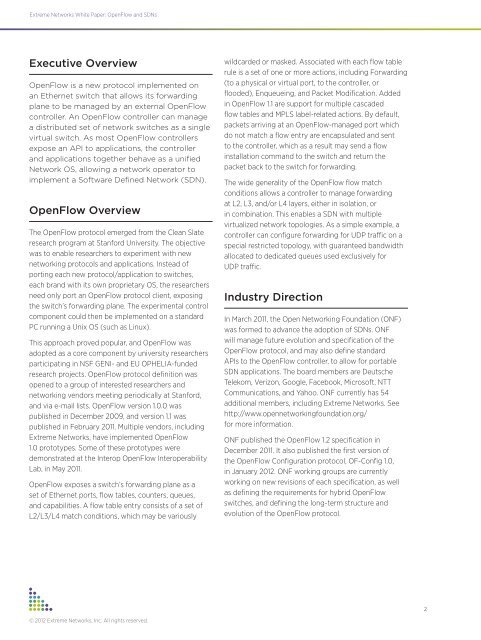OpenFlow and SDNS - Extreme Networks
OpenFlow and SDNS - Extreme Networks
OpenFlow and SDNS - Extreme Networks
You also want an ePaper? Increase the reach of your titles
YUMPU automatically turns print PDFs into web optimized ePapers that Google loves.
<strong>Extreme</strong> <strong>Networks</strong> White Paper: <strong>OpenFlow</strong> <strong>and</strong> SDNs<br />
Executive Overview<br />
<strong>OpenFlow</strong> is a new protocol implemented on<br />
an Ethernet switch that allows its forwarding<br />
plane to be managed by an external <strong>OpenFlow</strong><br />
controller. An <strong>OpenFlow</strong> controller can manage<br />
a distributed set of network switches as a single<br />
virtual switch. As most <strong>OpenFlow</strong> controllers<br />
expose an API to applications, the controller<br />
<strong>and</strong> applications together behave as a unified<br />
Network OS, allowing a network operator to<br />
implement a Software Defined Network (SDN).<br />
<strong>OpenFlow</strong> Overview<br />
The <strong>OpenFlow</strong> protocol emerged from the Clean Slate<br />
research program at Stanford University. The objective<br />
was to enable researchers to experiment with new<br />
networking protocols <strong>and</strong> applications. Instead of<br />
porting each new protocol/application to switches,<br />
each br<strong>and</strong> with its own proprietary OS, the researchers<br />
need only port an <strong>OpenFlow</strong> protocol client, exposing<br />
the switch’s forwarding plane. The experimental control<br />
component could then be implemented on a st<strong>and</strong>ard<br />
PC running a Unix OS (such as Linux).<br />
This approach proved popular, <strong>and</strong> <strong>OpenFlow</strong> was<br />
adopted as a core component by university researchers<br />
participating in NSF GENI- <strong>and</strong> EU OPHELIA-funded<br />
research projects. <strong>OpenFlow</strong> protocol definition was<br />
opened to a group of interested researchers <strong>and</strong><br />
networking vendors meeting periodically at Stanford,<br />
<strong>and</strong> via e-mail lists. <strong>OpenFlow</strong> version 1.0.0 was<br />
published in December 2009, <strong>and</strong> version 1.1 was<br />
published in February 2011. Multiple vendors, including<br />
<strong>Extreme</strong> <strong>Networks</strong>, have implemented <strong>OpenFlow</strong><br />
1.0 prototypes. Some of these prototypes were<br />
demonstrated at the Interop <strong>OpenFlow</strong> Interoperability<br />
Lab, in May 2011.<br />
<strong>OpenFlow</strong> exposes a switch’s forwarding plane as a<br />
set of Ethernet ports, flow tables, counters, queues,<br />
<strong>and</strong> capabilities. A flow table entry consists of a set of<br />
L2/L3/L4 match conditions, which may be variously<br />
wildcarded or masked. Associated with each flow table<br />
rule is a set of one or more actions, including Forwarding<br />
(to a physical or virtual port, to the controller, or<br />
flooded), Enqueueing, <strong>and</strong> Packet Modification. Added<br />
in <strong>OpenFlow</strong> 1.1 are support for multiple cascaded<br />
flow tables <strong>and</strong> MPLS label-related actions. By default,<br />
packets arriving at an <strong>OpenFlow</strong>-managed port which<br />
do not match a flow entry are encapsulated <strong>and</strong> sent<br />
to the controller, which as a result may send a flow<br />
installation comm<strong>and</strong> to the switch <strong>and</strong> return the<br />
packet back to the switch for forwarding.<br />
The wide generality of the <strong>OpenFlow</strong> flow match<br />
conditions allows a controller to manage forwarding<br />
at L2, L3, <strong>and</strong>/or L4 layers, either in isolation, or<br />
in combination. This enables a SDN with multiple<br />
virtualized network topologies. As a simple example, a<br />
controller can configure forwarding for UDP traffic on a<br />
special restricted topology, with guaranteed b<strong>and</strong>width<br />
allocated to dedicated queues used exclusively for<br />
UDP traffic.<br />
Industry Direction<br />
In March 2011, the Open Networking Foundation (ONF)<br />
was formed to advance the adoption of SDNs. ONF<br />
will manage future evolution <strong>and</strong> specification of the<br />
<strong>OpenFlow</strong> protocol, <strong>and</strong> may also define st<strong>and</strong>ard<br />
APIs to the <strong>OpenFlow</strong> controller, to allow for portable<br />
SDN applications. The board members are Deutsche<br />
Telekom, Verizon, Google, Facebook, Microsoft, NTT<br />
Communications, <strong>and</strong> Yahoo. ONF currently has 54<br />
additional members, including <strong>Extreme</strong> <strong>Networks</strong>. See<br />
http://www.opennetworkingfoundation.org/<br />
for more information.<br />
ONF published the <strong>OpenFlow</strong> 1.2 specification in<br />
December 2011. It also published the first version of<br />
the <strong>OpenFlow</strong> Configuration protocol, OF-Config 1.0,<br />
in January 2012. ONF working groups are currently<br />
working on new revisions of each specification, as well<br />
as defining the requirements for hybrid <strong>OpenFlow</strong><br />
switches, <strong>and</strong> defining the long-term structure <strong>and</strong><br />
evolution of the <strong>OpenFlow</strong> protocol.<br />
2<br />
© 2012 <strong>Extreme</strong> <strong>Networks</strong>, Inc. All rights reserved.

















